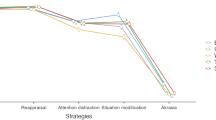Abstract
This research attempts to integrate self-determination theory with the construct of self-schema. Forty-nine schematic subjects (i.e., extreme on a personality dimension) received counterschematic feedback in either an ego-involving or non-ego-involving condition. Subjects’ autonomy versus control orientations were assessed. Results indicated that subjects with higher autonomy orientations changed less in response to counterschematic feedback than those with lower autonomy orientations. As well, subjects in the ego-involving condition changed more in the direction of the counterschematic feedback than those in the non-ego-involving condition. Findings suggest that both dispositional and situational factors account for differences in the degree to which individuals display consistency and self-awareness in processing information about themselves. Results are interpreted as support for the notion that greater autonomy is associated with a higher degree of self-knowledge and self-concept stability.
Similar content being viewed by others
References
Anderson, N. (1968). Likeableness ratings of 555 personality-trait words.Journal of Personality and Social Psychology, 9, 272–279.
Deci, E. L., & Ryan, R. M. (1985a).Intrinsic motivation and self-determination in human behavior. New York: Plenum Press.
Deci, E. L., & Ryan, R. M. (1985b). The general causality orientations scale: Self-determination in personality.Journal of Research in Personality, 19, 109–134.
Deci, E. L., & Ryan, R. M. (1987). The support of autonomy and the control of behavior.Journal of Personality and Social Psychology, 53, 1024–1037.
Deci, E. L., & Ryan, R. M. (1991). A motivational approach to self: Integration in personality. In R. Dienstbier (Ed.),Nebraska symposium on motivation: Vol. 38. Perspectives on motivation (pp. 237–288). Lincoln: University of Nebraska Press.
deCharms, R. (1968).Personal causation. The internal affective determinants of behavior. New York: Academic Press.
Exner, J. E. (1990).A Rorschach workbook for the comprehensive system (3rd ed.). Asheville, NC: Rorschach Workshops.
Greenwald, A., & Pratkanis, A. (1984). The self. In R. Wyer, Jr. & T. Srull (Eds.),Handbook of social cognition (Vol. 3, pp. 129–178). Hillsdale, NJ: Erlbaum.
Koestner, R., Bernieri, F., & Zuckerman, M. (1992). Self-regulation and consistency between attitudes, traits and behaviors.Personality and Social Psychology Bulletin 18, 52–59.
Koestner, R., & Zuckerman, M. (1994). Causality orientations, failure, and achievement.Journal of Personality, 62, 321–346.
Loevinger, J. (1976).Ego development. San Francisco: Jossey-Boss.
Markus, H. (1977). Self-schemata and processing information about the self.Journal of Personality and Social Psychology, 35, 63–78.
Markus, H. (1983). Self-knowledge: An expanded view.Journal of Personality, 51, 543–565.
Markus, H., & Kunda Z. (1986). Stability and malleability of the self-concept.Journal of Personality and Social Psychology, 51, 858–867.
Markus, H., & Wurf, E. (1987). The dynamic self-concept: A social psychological perspective.Annual Review of Psychology, 38, 299–337.
McAuley, E., Duncan, T., & Tammen, V. (1989). Psychometric properties of the Intrinsic Motivation Inventory in a competitive sport setting: A confirmatory factor analysis.Research Quarterly for Exercise and Sport, 60, 48–58.
Nurius, P., & Majerus, D. (1988). Rethinking the self in self-talk: A theoretical note and case example.Journal of Social and Clinical Psychology, 6, 335–345.
Plant, R. & Ryan, R. M. (1985). Intrinsic motivation and the effects of self-consciousness, self-awareness and ego-involvement: An investigation of internally controlling styles.Journal of Personality, 53, 435–449.
Pratkanis, A. R., & Greenwald, A. G. (1985). How shall the Self be conceived?Journal for The Theory of Social Behavior, 15, 311–329.
Rigby, C. S., Deci, E. L., Patrick, B. C. & Ryan, R. M. (1992). Beyond the intrinsic-extrinsic dichotomy: Self-determination in motivation and learning.Motivation and Emotion, 16, 165–185.
Ryan, R. M. (1982). Control and information in the intrapersonal sphere: An extension of cognitive evaluation theory.Journal of Personality and Social Psychology, 43, 450–461.
Ryan, R. M., Mims, V., & Koestner, R. (1983). Relation of reward contingency and interpersonal context to intrinsic motivation: A review and test using cognitive evaluation theory.Journal of Personality and Social Psychology, 45, 736–750.
Ryan, R. M. (1993). Agency and Organization: Intrinsic motivation, autonomy and the self in psychological development. In J. E. Jacobs (Ed.), Nebraska symposium on motivation: Development perspectives on motivation (Vol. 40, pp. 1–56). Lincoln, NE: University of Nebraska Press.
Shostram, E. L., (1966).Manual for the Personal Orientation Inventory. San Diego, CA: Educational and Industrial Testing Service.
Swann, W. B. Jr. (1983). Self-verification: Bringing social reality into harmony with the self. In J. Suls & A. G. Greenwald (Eds.),Psychological perspectives on the self (Vol. 2, pp. 33–66). Hillsdale, NJ: Erlbaum.
Swann, W. B. Jr., Stein-Seroussi, A., & Giesler, B. (1992). Why people self-verify.Journal of Personality and Social Psychology, 62, 392–401.
Author information
Authors and Affiliations
Additional information
This research was supported in part by the Frances L. Hiatt School of Psychology, Clark University.
Rights and permissions
About this article
Cite this article
Bober, S., Grolnick, W. Motivational factors related to differences in self-schemas. Motiv Emot 19, 307–327 (1995). https://doi.org/10.1007/BF02856517
Issue Date:
DOI: https://doi.org/10.1007/BF02856517




